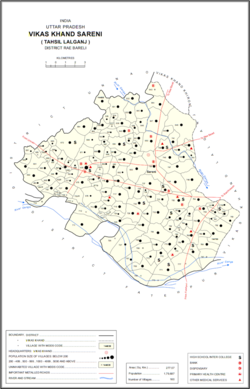|
Pithupur
Pithupur is a village in Sareni block of Rae Bareli district, Uttar Pradesh, India.[2] It is located 18 km from Lalganj, the tehsil headquarters.[3] As of 2011, it has a population of 928 people, in 185 households.[2] It has one primary school but no formal healthcare facilities.[2] It belongs to the nyaya panchayat of Bhoremau.[4] The 1951 census recorded Pithupur as comprising 1 hamlet, with a population of 271 people (136 male and 135 female), in 47 households and 45 physical houses.[5] The area of the village was given as 241 acres.[5] 10 residents were literate, 8 male and 2 female.[5] The village was listed as belonging to the pargana of Sareni and the thana of Sareni.[5] The 1961 census recorded Pithupur (as "Pithoopur") as comprising 1 hamlet, with a total population of 342 people (174 male and 168 female), in 52 households and 49 physical houses.[6] The area of the village was given as 241 acres.[6] It was part of Lalganj block at the time.[6] The 1981 census recorded Pithupur as having a population of 450 people, in 88 households, and having an area of 99.55 hectares.[3] The main staple foods were given as wheat and rice.[3] The 1991 census recorded Pithupur as having a total population of 593 people (280 male and 313 female), in 113 households and 110 physical houses.[4] The area of the village was listed as 100 hectares.[4] Members of the 0-6 age group numbered 133, or 22% of the total; this group was 50% male (66) and 50% female (67).[4] Members of scheduled castes made up 49% of the village's population, while no members of scheduled tribes were recorded.[4] The literacy rate of the village was 32% (135 men and 56 women).[4] 187 people were classified as main workers (146 men and 41 women), while 10 people were classified as marginal workers (1 man and 9 women); the remaining 396 residents were non-workers.[4] The breakdown of main workers by employment category was as follows: 107 cultivators (i.e. people who owned or leased their own land); 77 agricultural labourers (i.e. people who worked someone else's land in return for payment); 0 workers in livestock, forestry, fishing, hunting, plantations, orchards, etc.; 0 in mining and quarrying; 0 household industry workers; 0 workers employed in other manufacturing, processing, service, and repair roles; 0 construction workers; 1 employed in trade and commerce; 1 employed in transport, storage, and communications; and 4 in other services.[4] References
|
||||||||||||||||||||||||||||||||||

